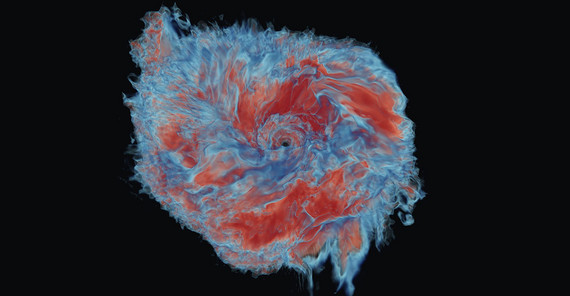“Our new method will help to analyze the properties of matter at extreme densities. It will also allow us to better understand the expansion of the universe and to what extent heavy elements are formed during neutron star mergers,” explains Tim Dietrich, Professor at the University of Potsdam and leader of a Max Planck Fellow group at the Max Planck Institute for Gravitational Physics. Dietrich is corresponding author of the paper.
A neutron star is a superdense astrophysical object formed at the end of a massive star's life in a supernova explosion. Like other compact objects, some neutron stars orbit each other in binary systems. They lose energy through the constant emission of gravitational waves – tiny ripples in the fabric of space-time – and eventually collide. Such mergers allow researchers to study physical principles under the most extreme conditions in the universe. For example, the conditions of these high-energy collisions lead to the formation of heavy elements such as gold. Indeed, merging neutron stars are unique objects for studying the properties of matter at densities far beyond those found in atomic nuclei.
The new method was applied to the first and so far only multi-messenger observation of binary neutron star mergers. In this event, discovered on August 17, 2017, the stars' last few thousand orbits around each other had warped space-time enough to create gravitational waves, which were detected by the terrestrial gravitational-wave observatories Advanced LIGO and Advanced Virgo. As the two stars merged, newly formed heavy elements were ejected. Some of these elements decayed radioactively, causing the temperature to rise. Triggered by this thermal radiation, an electromagnetic signal in the optical, infrared, and ultraviolet was detected up to two weeks after the collision. A gamma-ray burst, also caused by the neutron star merger, ejected additional material. The reaction of the neutron star's matter with the surrounding medium produced X-rays and radio emissions that could be monitored on time scales ranging from days to years.
The new tool for simultaneously analyzing astrophysical data from different sources allows researchers to interpret all these signals at the same time and to incorporate additional information from radio and X-ray observations of neutron stars (e.g., from NASA's NICER telescope), from nuclear physics calculations, and even from heavy-ion collision experiments at accelerators on Earth. “We can now go beyond the usual step-by-step combination process that we have done before. By analyzing coherently and simultaneously, we get more precise results,” says Peter T. H. Pang, scientist at Utrecht University, first author of the paper and lead developer of the code. To even further improve the developed software over the coming years, Dietrich was awarded with an ERC Starting Grant worth 1.5 million euros in 2022.
The gravitational-wave detectors are currently in their fourth observing run. The next detection of a neutron star merger could come any day, and the researchers are eagerly waiting to use the tool they developed again.
Link to Publication: Peter T. H. Pang, Tim Dietrich, Michael W. Coughlin et al., An updated nuclear-physics and multi-messenger astrophysics framework for binary neutron star mergers, 2023, Nature Communications, https://www.nature.com/articles/s41467-023-43932-6
Image: Numerical simulation of the resulting ejecta material of two merging neutron stars. Red colors refer to ejected material with a high fraction of neutrons which will appear typically redder than blue material that contains a higher fraction of protons. Image credit: Ivan Markin (Uni Potsdam).
Contact:
Prof. Dr. Tim Dietrich, Institute of Physics and Astronomy and Max-Planck-Institute for Gravitational Physics
Tel.: +49 331 977-230160
E-Mail: tim.dietrichuuni-potsdampde
Media Information 20-12-2023 / Nr. 130

